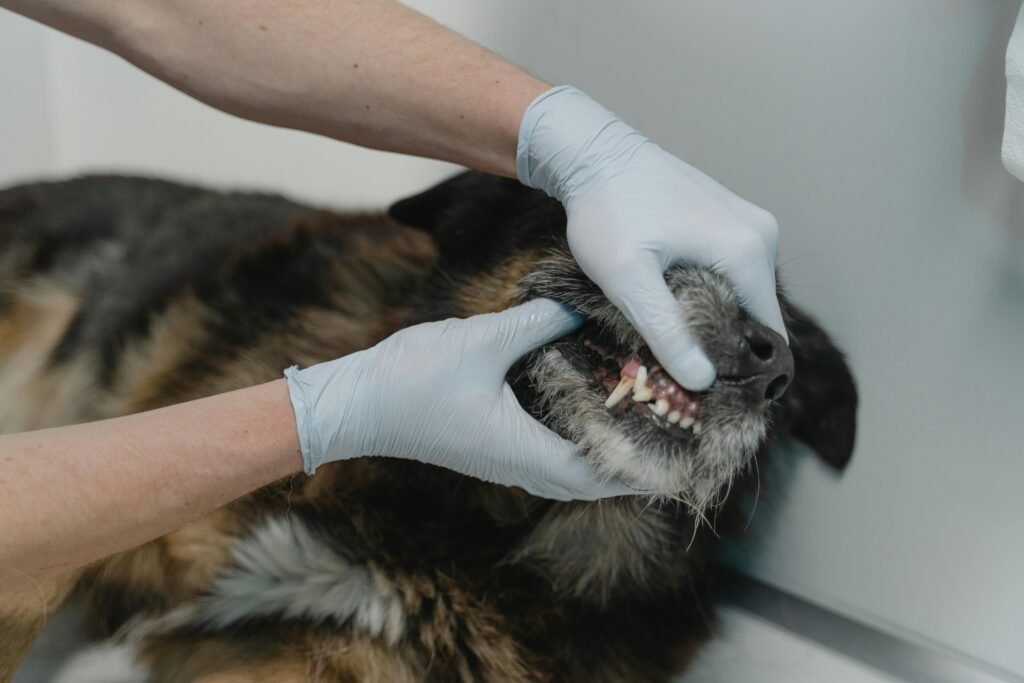Signs for Detecting Misalignment Early
Understanding your dog’s dental anatomy is the first step toward identifying potential Misaligned Canine Teeth in Dogs known as malocclusions. Dogs typically have 42 teeth: 20 in the upper jaw and 22 in the lower jaw. When their mouth is closed, the lower canine teeth, sometimes nicknamed “fang,” should comfortably fit between the third upper incisor and the upper canine tooth. Additionally, the upper molars should naturally overlap the lower four molars. Deviations from these norms could signal a malocclusion. Early detection plays a crucial role in successful management. During the crucial transition from baby teeth to permanent teeth (around 6-8 weeks old), be observant of any potential signs, such as:
- Difficulty chewing kibble or toys, often dropping or struggling with food.
- Excessive drooling, which can be a sign of pain or discomfort.
- Visible misalignment of teeth, where teeth appear crowded, overlapping, or protruding awkwardly.
- Facial asymmetry, where one side of the jaw appears different from the other.
Early intervention is key, as it allows for preventive measures like extracting stubborn baby teeth to create space for proper permanent tooth eruption. Regular dental checkups every 6-12 months, depending on your dog’s breed and age, are vital for early detection and intervention.

Understanding the Causes of Misaligned Canine Teeth in Dogs?
Several common culprits can contribute to misaligned teeth in dogs:
- Abnormal tooth angle or direction: Imagine the lower canine tooth growing inward, like a tiny, uncomfortable fence post poking the roof of your dog’s mouth. This inward angulation, known as linguoversion, can cause pain and damage to other teeth.
- Skeletal deformities: Conditions like brachycephalic syndrome, prevalent in short-nosed breeds like pugs and bulldogs, lead to jaw abnormalities like shorter muzzles, which can impact teeth alignment.
- Retained baby teeth: Sometimes, stubborn baby teeth refuse to fall out naturally, preventing permanent teeth from erupting in their rightful positions, leading to crowding and misalignment.
Understanding the cause of Misaligned Canine Teeth in Dogs is crucial for determining the most appropriate management approach.
Tailored Management Options for Misaligned Canine Teeth in Dogs
While prevention through early detection is ideal, several treatment options exist depending on the severity and type of malocclusion your dog faces. Here’s a deeper dive into the tools at your veterinarian’s disposal:
Early Detection and Prevention: The Cornerstone of Healthy Smiles
As mentioned earlier, this golden rule cannot be emphasized enough. Regular puppy checkups from 6-8 weeks old allow early identification of potential issues. In some cases, simply extracting stubborn baby teeth creates space for permanent teeth to erupt properly, preventing future complications. These regular dental checkups become even more crucial in brachycephalic breeds prone to jaw and teeth abnormalities. Remember, early intervention minimizes the need for more invasive procedures later.
Passive Orthodontic Devices: Guiding Young Teeth Gently
For young dogs (around 7-8 months old) with developing malocclusions, inclined plane bite plates offer a gentle approach. These temporary, acrylic devices, custom-fitted to your dog’s teeth, act as inclined planes, gradually guiding misaligned teeth back into their proper positions during mouth closure. Regular brushing ensures optimal hygiene and effectiveness. While temporary options exist, permanent ones offer better compliance and adherence.
Crown Reduction: A Balancing Act for Adult Teeth
For adult dogs with mild malocclusions, crown reduction, also known as dental shortening, can be considered. This procedure involves carefully removing a small portion of the affected tooth’s crown (top) to create space for proper alignment. However, caution is paramount, as excessive reduction can expose the sensitive pulp, requiring further treatments like vital pulp therapy. This delicate procedure necessitates an experienced veterinarian’s expertise and careful radiographic assessment beforehand. Close monitoring and follow-up appointments are essential to ensure proper healing and continued comfort.
Tooth Extraction: A Last Resort with Careful Consideration
This option carries both functional and aesthetic drawbacks, making it a last resort. Reserved for severe cases where other options are ineffective, it involves extracting the problematic tooth, often the mandibular canine (fang). Due to its large size and strong root structure, extraction can be challenging and carries potential functional consequences, like affecting bite and chewing ability. Additionally, cosmetic considerations arise, especially for aesthetically-driven breeds. A thorough discussion with your veterinarian, weighing the risks and benefits in light of your dog’s specific situation, is crucial before making this decision.
Emerging Solutions on the Horizon:
Veterinary dentistry is constantly evolving, offering new possibilities for managing Misaligned Canine Teeth in Dogs. Advanced techniques like 3D printing for custom prosthetics and minimally invasive surgical approaches are being explored. While currently less common, these advancements might become more accessible in the future, offering even more tailored treatment options for our canine companions.
Remember, the best approach to managing misaligned teeth in your dog involves early detection, open communication with your veterinarian, and understanding the available options. Together, you can ensure your furry friend’s comfort, optimal oral health, and a happy, healthy smile for years to come. By understanding the different types of malocclusions, their causes, and available management options, you can work with your veterinarian to ensure your dog’s dental health and prevent potential complications
Reference:
Gorrel, C., Andersson, S., & Verhaert, L. (2013). Veterinary Dentistry for the General Practitioner2: Veterinary Dentistry for the General Practitioner. Elsevier Health Sciences.
Fulton, A. J., Fiani, N., & Verstraete, F. J. (2013). Canine Pediatric Dentistry.Veterinary Clinics of North America: Small Animal Practice.

